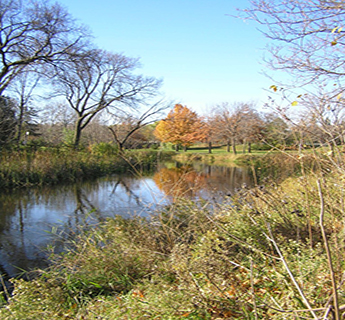Stormwater Management: Manage natural areas in and around surface waters, as well as stormwater ponds and other stormwater treatment facilities, as areas supportive of aquatic and terrestrial ecosystems.

To protect the city’s water systems, stormwater ponds and other stormwater treatment facilities, it’s essential to manage the landscape surrounding the city’s surface waters. Supporting healthy ecosystems within these natural areas serves as a defense barrier for local water bodies. These environments have stable and nutritious soils, a diversity of native plant communities, and insect and animal habitats; and they can infiltrate and naturally treat contaminated soils and filter surface runoff before it enters the city’s water systems. Strong ecosystems bordering surface waters also mitigate floodwaters and provide important shading to cool water temperatures during warm seasons, which helps improve water quality.
 ACTION STEPS
ACTION STEPS
The City will seek to accomplish the following action steps to manage natural areas in and around surface waters, as well as stormwater ponds and other stormwater treatment facilities, as areas supportive of aquatic and terrestrial ecosystems.
- Use infiltration best practices and bio-infiltration to reduce stormwater impacts on surface waters.
- Continue work to reduce risk of overflows from the historically connected sewers and work to reduce infiltration and inflow into the city’s sanitary sewer system through infrastructure improvements.
- Encourage and require reductions in amounts of impervious surfaces. Pilot and promote permeable surface solutions as alternatives to impervious surfaces.
- Use hydraulic and water quality models and data about infrastructure condition and risks to prioritize and inform investments in sanitary and storm infrastructure.
- Protect aquatic habitat from invasive species that may pose an economic, water quality or public health issue.
- Increase habitat and natural areas around public stormwater infrastructure and natural water bodies while maintaining and prioritizing stormwater function and controlling invasive species through an integrated pest management program.
- Manage stormwater management facilities to provide habitat for pollinators while maintaining and prioritizing stormwater function.
- Strive for interconnected riparian areas as habitat corridors and for flood protection and recreation, and create additional “steppingstone” areas for habitat.
- Explore the impacts of flooding on public safety, the protection of property, public infrastructure and the environment.
- Manage and design transportation infrastructure with a priority on water quality through the reduction of stormwater runoff and pollutants including road salt.
- Evaluate and adopt alternatives and best practices for use of road salt to reduce pollution of local waterways; adopt MPCA salt training and guidelines for City crews.

